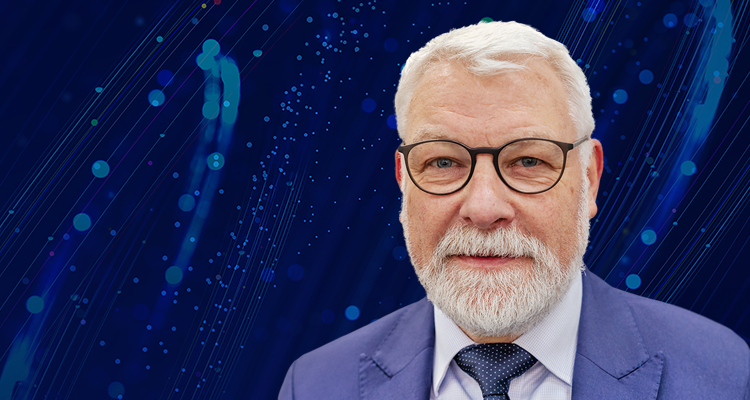
Tom Richter shares insights into harnessing the promise of the digital era
As the Global Head of Discrete & Process Manufacturing Verticals for Digital Industries in Nokia Enterprise Sales, Tom Richter is responsible for the design and specification of tailored network solutions based on the specific vertical requirements of manufacturing companies. With more than 25 years’ experience in sales, marketing and commercial management and a profound technical understanding of the underlying technologies, he provides support for the Nokia sales colleagues to serve this new customer segment.
“I started my career on the enterprise side, selling POB access to small- and medium-sized enterprises in the late 90s,” Tom begins. “This was at the time when we switched from analog phones to digital. Since then, while I’ve worked in the same company, my roles have been so varied that it feels like I’ve worked for different organizations. I moved over to the mobile business, working with service providers, which took me overseas for a number of years, serving the technical sales side as an account manager for one of our global customers.
“With experience in numerous functions, I came to where I am now, bringing mobile technology and wireless connectivity to enterprises, with huge potential for digitalization and Industry 4.0, particularly in terms of standardization and affordability.
 Enhancing accessibility
Enhancing accessibility
“Nokia has been engaged in the enterprise business for quite some time, with verticals like energy and transport, initially with IP networks, but also wireless networks like EMR. There is opportunity to diversify into other enterprise verticals, with value in looking at different technologies, such as 5G. As such, as part of my role, I’m exploring the specific requirements of manufacturing companies.
“While the technology platform is good, it requires customization and products need to be tailored to the specific needs in manufacturing. This goes far beyond radio requirements; rather, an end-to-end solution is needed, one where interoperability, functionality, and cybersecurity all come into play. The technology needs to be able to be deployed across the board, by manufacturers large and small, and especially by small-to-medium-sized enterprises. Mastering the digital transformation can be a challenge, so it is down to us to make it easier to digest. We were among the first to offer customized solutions, by selecting the portion of our portfolio, deemed best suited to a client’s niche requirements.
“Cloud computing is one of the foundational technologies, but it also needs to be brought down to the shop floor. Manufacturing is a homogenous industry with diverse sub-sectors. As such, we need to understand unique requirements and the different ways of working. We need to identify trends and gaps in provision and bring that data to our product development team. On the other side of things, my role is to educate our salesforce to speak the language of the industry. By bringing the right people together, we can make our offering more accessible to the end user,” Tom explains.
Indeed, to capture companies’ current maturity and mid-term goals in adopting enterprise and industrial metaverse use cases, Nokia worked in partnership with EY to conduct a new study called The Metaverse at Work. Based on an online survey, the findings assess the key drivers, benefits, challenges and risks associated with deploying use cases in the metaverse, as well as the enablers and partnerships required to drive value.
“We need to think about how we can make it easier for manufacturers to get engaged to gain practical experience,” he continues. “As the survey reveals, those engaged in doing something are seeing greater potential therein. The industrial and enterprise metaverses are exceeding expectations and experienced companies report more benefits than companies still in the planning phase. There are challenges as the enterprise and industrial metaverses require an extensive set of technical enablers, with cloud computing, AI, and network infrastructure and connectivity being ranked most important. It’s crucial to find proof points for decision makers to see the value in such an undertaking. The study has proven that in the numbers.”
Industry expertise
In terms of helping manufacturers take their first steps on the journey, Nokia offers a portfolio of connectivity solutions. Tom elaborates: “We need to dig deeper into industries to understand them better, to tailor products for the different verticals. It proves the point that industry expertise is necessary. I think Nokia is a front runner. We can bring a holistic perspective, not simply sell a single product to solve one problem.
“If you look back to our newly formulated strategy, for instance, you will find those topics which reached far beyond tomorrow already. Here again, the loop is closing because the metaverse is part of our strategy in a very specific manner. We are not citing the metaverse as a buzzword, we have an idea of what it would mean for businesses in different segments and we have the competence in-house to bring the big picture to organizations, small and large.”
Digital generation 
Indeed, organizations that want to modernize and transition to more digitalized and connected business models and take advantage of the tools and applications of future industries, must shift their network infrastructures to flexible, high-performance networks providing ubiquitous, robust connectivity. Transport networks, edge cloud and interconnected data centers will be required to enable the processing of massive amounts of data necessary to support mission-critical operations and generate even deeper insights to further improve operations. End-to-end private wireless networks will also be critical for supporting machine-to-machine communications, remote monitoring and management, and digital-physical fusion.
“For me, the metaverse is an evolutionary story, which is now almost certainly being accelerated by other trends in the industry, such as staff shortages and dwindling expertise. As such, those products on the training and operational side will be massively in demand in the coming years. This is where the ICT industry can help to combat operational challenges. Perhaps not always directly but certainly indirectly, we can help to improve efficiencies. If, for example, you can avoid trialing processes in the real world by incorporating digital simulations, then efficiencies and savings can be made in terms of not wasting man hours and resources,” Tom enthuses.
Indeed, working environments are transitioning to ones where humans are augmented by technology advancements. “We will see AI everywhere. Artificial intelligence is necessary to make sense out of the vast amounts of unstructured data. As AI tools are developing at pace, which is triggered by advances in the consumer world, they are becoming increasingly sophisticated and structuring data in a more effective way. While we are providing context, machines are handling the data volume and removing bias. Experience is good, but it can also be misleading. Circumstances change, but can humans adapt that quickly?” he questions.
When considering those new to the industry, attracting and retaining talent with more productive and satisfying ways of working for the digital generation will prove to be a key element for companies looking to assure the stability of their future workforce. Tom believes that digital natives want to work with cutting-edge technologies and “the challenge is to adopt technology and to do it in a meaningful way that provides a return on investment.”
The bigger picture
To stay ahead of the curve, Tom strives to keep his finger on the pulse in terms of sector and wider industry trends. “ICT, along with other industries, is on the cusp of convergence and we need to be ready and willing to cope with that. Training and knowledge sharing can facilitate transformation, along with staying open and listening to others.
“Digital transformation should be at the top of everyone’s agenda, as should consideration of digital threats. It’s important to make considered, comprehensive decisions that assess each stage of the digital journey, particularly in terms of foundational technologies and platforms, to avoid data siloes.
“Looking to the future and the circular economy, there’s much more to come. To make a circular industry work, you need interoperability, transferability, transparency, and cybersecurity,” Tom concludes. “We’re currently carving out first examples and ideas of how this could work, which will keep us busy for the next couple of years. The concept is starting small, but it will grow, and all the pointers suggest that we need to master the big picture.”